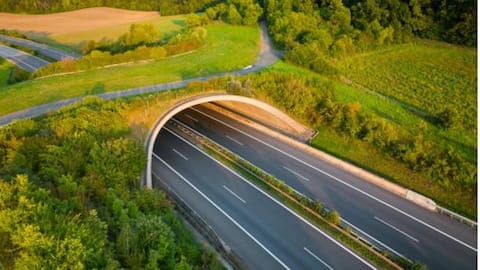World Wildlife Day 2025: How wildlife corridors help species thrive
What's the story
World Wildlife Day, observed on March 3, 2025, celebrates the planet's diverse biodiversity, highlighting their vital role in sustaining healthy ecosystems.
With over a million species at risk, it also calls for urgent action against wildlife crime and human-driven species decline.
As climate change, pollution, and habitat loss accelerate, wildlife corridors emerge as a key conservation strategy.
Safe passages
What are wildlife corridors and why are they important?
Wildlife corridors, natural or man-made, connect fragmented habitats, allowing animals to migrate, find food, and reproduce freely.
These passageways include forested strips, riverbanks, underpasses, and bridges over highways.
Without them, species face isolation, inbreeding, and extinction risks.
By preserving ecological connectivity, wildlife corridors support healthy populations and biodiversity, ensuring long-term ecosystem balance.
Deforestation
Preventing habitat fragmentation
One of the biggest threats to wildlife today is habitat fragmentation, caused by deforestation, agriculture, and expanding urban areas.
This disrupts animal movement, leaving populations stranded in small, disconnected areas.
Wildlife corridors counteract this issue by providing safe routes between habitats, allowing species to roam freely.
This helps maintain balanced ecosystems and prevents species decline due to isolation.
Survival rates
Enhancing genetic diversity
Genetic diversity is crucial for species' survival, as it enables them to adapt to environmental changes and resist diseases.
When animal populations are confined to limited areas, inbreeding reduces genetic variation, making species more vulnerable.
Corridors allow individuals from different groups to intermix, enhancing genetic diversity and improving long-term survival rates.
Conflicts
Reducing human-wildlife conflict
As human settlements expand, encounters between people and wildlife have become more frequent, leading to conflicts such as crop damage, livestock attacks, and road accidents.
Wildlife corridors provide designated safe passages for animals, reducing their need to venture into human-dominated areas.
This not only protects wildlife but also ensures the safety of local communities and minimizes economic losses.
Weather patterns
Helping species adapt to climate change
Rising temperatures and changing weather patterns are forcing many species to shift their habitats in search of cooler climates, food sources, and breeding grounds.
Wildlife corridors enable these natural migrations, helping species escape extreme conditions and maintain their populations.
Without such connectivity, many animals would struggle to survive in a rapidly changing environment.
Kanha-Pench
Notable wildlife corridor projects
Several conservation initiatives worldwide have successfully implemented wildlife corridors.
India's Kanha-Pench corridor supports tiger movement between national parks, while the Yellowstone to Yukon corridor in North America helps large mammals like bears and wolves migrate freely.
In Europe, eco-bridges and green underpasses allow deer, amphibians, and other animals to safely cross highways, reducing roadkill incidents.
Collective action
The future of wildlife corridors
Protecting and expanding wildlife corridors requires collective action from governments, conservationists, and local communities.
Strategies such as reforestation, sustainable land use planning, and the construction of eco-friendly infrastructure can help secure these essential pathways.
By investing in wildlife corridors, we can ensure that species continue to thrive, maintaining the delicate balance of our ecosystems for future generations.
